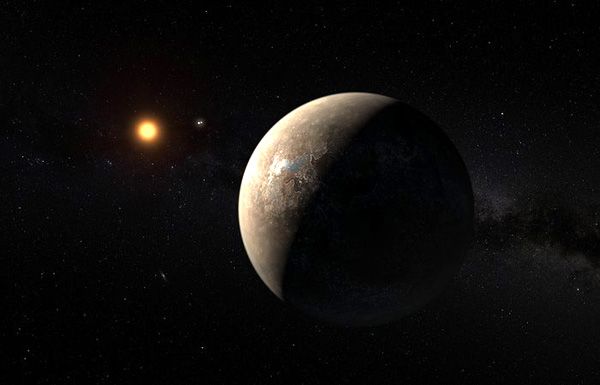
ESO / M. Kornmesser
Planet Found in Habitable Zone Around Nearest Star (Press Release)
Pale Red Dot campaign reveals Earth-mass world in orbit around Proxima Centauri
Astronomers using ESO telescopes and other facilities have found clear evidence of a planet orbiting the closest star to Earth, Proxima Centauri. The long-sought world, designated Proxima b, orbits its cool red parent star every 11 days and has a temperature suitable for liquid water to exist on its surface. This rocky world is a little more massive than the Earth and is the closest exoplanet to us — and it may also be the closest possible abode for life outside the Solar System. A paper describing this milestone finding will be published in the journal Nature on 25 August 2016.
Just over four light-years from the Solar System lies a red dwarf star that has been named Proxima Centauri as it is the closest star to Earth apart from the Sun. This cool star in the constellation of Centaurus is too faint to be seen with the unaided eye and lies near to the much brighter pair of stars known as Alpha Centauri AB.
During the first half of 2016 Proxima Centauri was regularly observed with the HARPS spectrograph on the ESO 3.6-metre telescope at La Silla in Chile and simultaneously monitored by other telescopes around the world. This was the Pale Red Dot campaign, in which a team of astronomers led by Guillem Anglada-Escudé, from Queen Mary University of London, was looking for the tiny back and forth wobble of the star that would be caused by the gravitational pull of a possible orbiting planet.
As this was a topic with very wide public interest, the progress of the campaign between mid-January and April 2016 was shared publicly as it happened on the Pale Red Dot website and via social media. The reports were accompanied by numerous outreach articles written by specialists around the world.
Guillem Anglada-Escudé explains the background to this unique search: “The first hints of a possible planet were spotted back in 2013, but the detection was not convincing. Since then we have worked hard to get further observations off the ground with help from ESO and others. The recent Pale Red Dot campaign has been about two years in the planning.”
The Pale Red Dot data, when combined with earlier observations made at ESO observatories and elsewhere, revealed the clear signal of a truly exciting result. At times Proxima Centauri is approaching Earth at about 5 kilometres per hour — normal human walking pace — and at times receding at the same speed. This regular pattern of changing radial velocities repeats with a period of 11.2 days. Careful analysis of the resulting tiny Doppler shifts showed that they indicated the presence of a planet with a mass at least 1.3 times that of the Earth, orbiting about 7 million kilometres from Proxima Centauri — only 5% of the Earth-Sun distance.
Guillem Anglada-Escudé comments on the excitement of the last few months: "I kept checking the consistency of the signal every single day during the 60 nights of the Pale Red Dot campaign. The first 10 were promising, the first 20 were consistent with expectations, and at 30 days the result was pretty much definitive, so we started drafting the paper!"
Red dwarfs like Proxima Centauri are active stars and can vary in ways that would mimic the presence of a planet. To exclude this possibility the team also monitored the changing brightness of the star very carefully during the campaign using the ASH2 telescope at the San Pedro de Atacama Celestial Explorations Observatory in Chile and the Las Cumbres Observatory telescope network. Radial velocity data taken when the star was flaring were excluded from the final analysis.
Although Proxima b orbits much closer to its star than Mercury does to the Sun in the Solar System, the star itself is far fainter than the Sun. As a result Proxima b lies well within the habitable zone around the star and has an estimated surface temperature that would allow the presence of liquid water. Despite the temperate orbit of Proxima b, the conditions on the surface may be strongly affected by the ultraviolet and X-ray flares from the star — far more intense than the Earth experiences from the Sun.
Two separate papers discuss the habitability of Proxima b and its climate. They find that the existence of liquid water on the planet today cannot be ruled out and, in such case, it may be present over the surface of the planet only in the sunniest regions, either in an area in the hemisphere of the planet facing the star (synchronous rotation) or in a tropical belt (3:2 resonance rotation). Proxima b's rotation, the strong radiation from its star and the formation history of the planet makes its climate quite different from that of the Earth, and it is unlikely that Proxima b has seasons.
This discovery will be the beginning of extensive further observations, both with current instruments and with the next generation of giant telescopes such as the European Extremely Large Telescope (E-ELT). Proxima b will be a prime target for the hunt for evidence of life elsewhere in the Universe. Indeed, the Alpha Centauri system is also the target of humankind’s first attempt to travel to another star system, the StarShot project.
Guillem Anglada-Escudé concludes: "Many exoplanets have been found and many more will be found, but searching for the closest potential Earth-analogue and succeeding has been the experience of a lifetime for all of us. Many people’s stories and efforts have converged on this discovery. The result is also a tribute to all of them. The search for life on Proxima b comes next...
Source: European Southern Observatory
****

ESO / M. Kornmesser

No comments:
Post a Comment